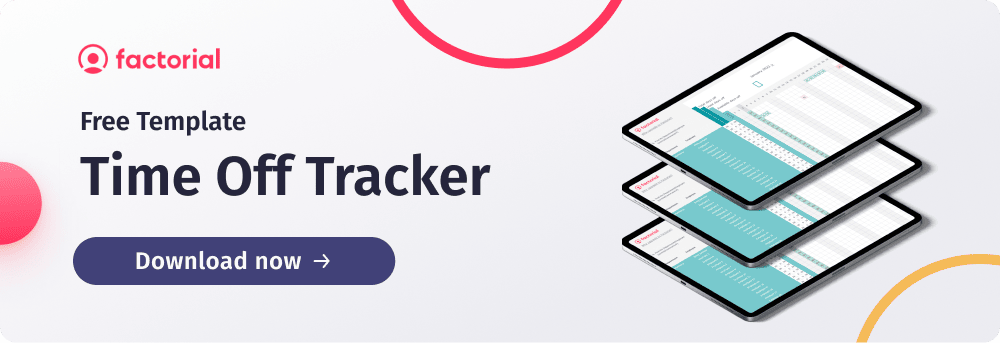Navigating the different leave of absence types and types of time off may seem like a confusing, overwhelming, and daunting task. Needless to say, there are many factors that influence an employer’s leave of absence practices, policies, and decisions. This article will help you break down the different leave of absence types, types of time off, and their corresponding legislatures.
Although it may seem complicated, fear not, everything you need to know about types of leave of absence and time off is right here!

Leave of Absence Meaning
The meaning of “leave of absence” is permission granted by an employer, for an employee to not have to work for a set amount of time.
Generally speaking, there are two types of leave of absence: voluntary and mandatory. With mandatory leave of absence, there are corresponding federal or state laws that protect employees. However, voluntary leave of absence is part of a company’s internal policies.
Leave of absence laws can be requested for a number of different reasons, including the following:
- Personal or family illness
- Mental health
- Holiday
- Statutory or contractual holiday entitlements
- Pregnancy
- Bereavement leave
- Medical appointments
- Jury duty
- Military service
- Voting
- Personal reasons
Leave of Absence vs. Paid Time Off: What is the Difference?
A common question is “is a leave of absence the same as time off”? The answer is: Not exactly.
Many employers provide their employees with annual paid time off and holiday time as a part of their contractual working agreement. Unlike the many types of time off, employees take leave of absence when they are dealing with personal, medical, or familial problems. And as mentioned above, the allowance for time off is either mandatory or part of a company’s internal policy.
Leave of absence policies and time off policies are produced to help manage employee absences. They both highlight the different types of leave that employees are permitted and what the limits and requirements for that leave are. In order to ensure compliance with federal and state laws, it is essential to be familiar with the legislation governing all forms of employee leave.
Paid Time Off and Leave of Absence Laws
There are laws that need to be taken into consideration when writing a leave of absence policy. Complying with these will help you avoid any potential employee disputes or misunderstandings.
Employees are allowed to take time off work when they are ill. The only thing they need to do is give their employer proof of their illness if they are ill for more than 7 days. In case they are ill before or during their holiday, they can take it as sick leave instead.
Types of Leave of Absence
Employees may require paid time off for many different reasons: including sick leave, personal days off, and holidays. Efficient time off is vital to boost employee satisfaction and productivity levels.
Paid time off is a benefit program that enables employees to take time off work for a certain number of days and still get paid. In Europe, workers are guaranteed between 20-30 paid days off work per year. In the UK, employees are entitled to 5.6 weeks of paid holiday each year (known as statutory leave entitlement or annual leave), including bank holidays.
Adoption pay and leave
Employees who want to take time off to adopt a child or have a child through a surrogacy arrangement might be eligible for one of the following leaves of absence:
- Statutory Adoption Leave
- Statutory Adoption Pay
Agricultural Sick Pay
Agricultural Sick Pay (ASP) means that employees who are off work due to sickness are paid at least the Agricultural Minimum Wage in the UK. This includes any Statutory Sick Pay that the employees may be entitled to. Note that your employees have the right to Agricultural Sick Pay only if they were employed before the rules changed on 1 October 2013 and if it is written in their contracts.
Appeal a call-up to the reserve forces
Employees can appeal to the Reserve Forces Appeal Tribunals (RFAT) in two situations:
- if they are in the UK reserve forces and their request for exemption from service has been turned down
- if they employ a reservist and their request for their exemption from service has been turned down
Career breaks
Employees can take career breaks only by having an agreement between the employer and the employee. Employers usually do not offer career breaks, but in case they do, they need to lay out a clear policy which will cover the following:
- eligibility and notice periods;
- the application procedure and the allowed length of days
- qualification for pay increases
Since there are no laws that deal specifically with taking a career break, employees can make arrangements to return to work after a career break. However, these agreements are not legally binding and it could mean ending the existing contract of employment.
Maternity Allowance
Maternity Allowance is a payment that female employees can get when they are about to have a baby. This allowance can last for up to 39 weeks. Female employees can claim Maternity Allowance as soon as they have been pregnant for at least 26 weeks. The Maternity Allowance payment can begin up to 11 weeks before the baby is due. Employees can get it in the following situations:
- When they are employed but can’t get Statutory Maternity Pay (SMP)
- If they are self-employed
- When they stopped working in the recent past
- If they take part in unpaid work for their spouse’s business
Maternity Pay and Leave
When employees need to take time off in order to have a baby, they might be eligible for one of the following:
- Statutory Maternity Leave
- Statutory Maternity Pay
- Paid time off for antenatal care
- Extra help from the government
Employees qualify for Statutory Maternity Leave only if they are employees and not ‘workers’, and if they provide the correct notice to their employer, regardless of how long they’ve been with their employer, how many hours they work or how much they get paid.
To qualify for Statutory Maternity Pay (SMP), female employees must:
- earn on average at least £123 a week
- give the correct notice and pregnancy proof
- have worked for their employer for at least 26 weeks continuing into the ‘qualifying week’ – the 15th week before the expected week of childbirth
Employees can still get Statutory Maternity Leave and SMP in situations when their baby is born early, is stillborn after the start of their 24th week of pregnancy, or if it dies after being born.
Paternity Pay and Leave
When employees need to take time off because their partner is having a baby, or they are adopting a child, or they are having a baby through a surrogacy arrangement, they might be eligible for one of the following:
- 1 or 2 weeks of paid Paternity Leave
- Paternity Pay
- Shared Parental Leave and Pay
Employees need to be taking time off to look after the child in case they are one of the following:
- the father
- the husband or partner of the mother (or adopter) – including same-sex partners
- the child’s adopter
- the intended parent (through a surrogacy arrangement)
Employees qualify for a Paternity Leave if they are employees, give the correct notice and have been continuously employed for at least 26 weeks up to any day in the ‘qualifying week’. The ‘qualifying week’ is the 15th week before the baby is due.
To qualify for Paternity Pay, employees must:
- be employed up to the date of birth
- earn at least £123 a week (before tax)
- give the correct notice
- have been continuously employed by your employer for at least 26 weeks up to any day in the ‘qualifying week’
Shared Parental Leave and Pay
Employees and their partners may be able to get Shared Parental Leave (SPL) and Statutory Shared Parental Pay (ShPP) if they are:
- having a baby
- using a surrogate in order to have a baby
- adopting a child
- fostering a child
With the shared leave, both the employee and their partner can share up to 50 weeks of leave and up to 37 weeks of pay between themselves. They can use Shared Parental Leave (SPL) to take blocks of leave separated by work periods or take the entire leave in one go. To get SPL and/or ShPP, the employees and their partners need to meet the eligibility criteria, give notice to their employers, and give up some of the maternity or adoption leave and pay.
Statutory Parental Bereavement Pay and Leave
Employees and their partners may be able to take time off work if their child dies before they turn 18, or if they have a stillbirth after 24 weeks of pregnancy. The death or stillbirth must have happened on or after 6 April 2020 for employees in England, Scotland or Wales, or on or after 6 April 2022 for employees in Northern Ireland. In that case, employees may be eligible for either a Parental Bereavement Leave or Statutory Parental Bereavement Pay. They just need to know the rules for taking this leave and pay and how to claim them.
Statutory Sick Pay (SSP)
Employees who are too ill to work can get £99.35 per week in Statutory Sick Pay (SSP). The employer pays this sick pay for up to 28 weeks. Employees only need to satisfy certain eligibility criteria for SSP. They need to check their employment contracts and see how much money they are eligible to get. They can’t get less than the statutory amount. However, they can get more if their company has a sick pay scheme (or ‘occupational scheme’).
Note that there are different sick pay rules for agricultural workers. Check above.

Suspensions from work for medical reasons
Employers can suspend employees from work if their health and safety are put in danger. This can be either a medical suspension, if they have a serious allergic reaction to a chemical that is used at work, or a suspension for maternity reasons, if they’re pregnant and work in a lab that uses radiation.
Taking sick leave
When being ill, employees can take time off work. They only need to provide their employer with proof of their illness if it is longer than 7 days. Note that employees must give their employer a ‘fit note’, also known as a ‘sick note’ when they’ve been ill for more than 7 days in a row. This includes non-working days, such as weekends and bank holidays. The fit note will state that the employee is either “not fit for work” or “may be fit for work”.
Time off for family and dependants
Employees are allowed time off to deal with an emergency involving a dependant, who could be a child, grandchild, spouse, partner, parent, or someone who depends on you for care.
When it comes to an emergency, employees are allowed a reasonable amount of time off to deal with it, but it depends on the situation. Note that there are no limits on how many times employees can take time off for dependants. However, employers may want to talk to their employees if they think the time off is affecting their work.
Employees are not allowed time off if they knew about a situation beforehand. For example, time off for family or dependants will not be covered if employees wanted to take their dependants to the hospital for an appointment.
Employers may allow their employees to take a “compassionate leave” (paid or unpaid leave for emergency situations) if they are not giving them time off for dependants.
Time off work for public duties
Employees can get time off work for certain public duties. Employers can choose to pay them for this time, but they don’t have to.
The amount of time off for public duties should be agreed upon beforehand, based on:
- the length of time that the public duties might take
- the amount of time the employee has already had off for public duties
- the way that the time off will affect the business
Employers can refuse a request for time off for public duties if they think it’s unreasonable. However, they can’t refuse a request for jury service.
Training and study at work: your rights
Employees may ask for time off work for training or study purposes. To be able to ask for such time off, employees need to:
- be classed as an employee
- have worked for their employer for at least 26 weeks
- make sure that the training will help them do their job better
- have at least 250 people working in the organisation
Note that time off is usually unpaid unless the employer agrees to pay it.
Travel disruption and work
Employees who are faced with a certain travel disruption need to talk to their employer about working from home, taking leave or making time up later.
In case the workplace is closed due to a disruption, employers may ask their employees to go to another workplace or work from home. When the employee’s child’s school is closed or their normal childcare arrangements are disrupted, they have the right to take time off in order to look after them.
UK bank holidays
As an employer, it is important to be aware of all of the Bank Holidays in the UK, including the extra bank holiday in 2022. Bank holidays were first introduced by the Bank Holidays Act of 1871 and were named bank holidays because banks would traditionally close on these days. Other companies who were dependent on the banks to conduct their business would close too on these days, thus making them official national holidays.
Unpaid parental leave
Employees who want to look after their child’s welfare, are eligible to take unpaid parental leave to:
- spend more time with their children
- look at new schools
- enrol children into new childcare arrangements
- spend more time with family
What About Unpaid Leave?
Unpaid leave of absence is defined as a period of time taken off from work that is not covered by existing employee benefits such as paid vacation, paid time off, or sick leave.
Full-time employees are entitled to a minimum of 5.6 weeks of paid leave each year, known as statutory leave entitlement. Employees are also entitled to paid sick leave, maternity leave (up to 39 weeks) and paternity leave (up to 2 weeks). Any other days off where employees are not entitled to statutory pay is known as unpaid leave.
Managing Different Types of Leave and Leave Requests
Offering holidays is not required by federal law in the US. However many companies offer it as part of their employee package to attract high-calibre employees and contribute to the overall success and productivity of the company. Managing vacation requests can prove difficult. However, it is made simpler when you have an intuitive and automated time-tracking system to help.
Manage all leave of absence quickly and easily with Factorial HR!


